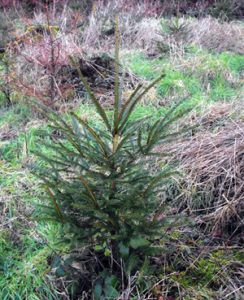A tree at Christmas

For many, the Christmas tree is an essential part of the celebrations. Selecting your tree from a local garden centre or a woodland (that grows and sells trees by the thousand) then decorating it and surrounding it with presents, is part and parcel of the festivities. But when did these activities start ?
Winter celebrations date back many centuries and many are associated with the winter solstice, which marks the shortest day and longest night (in northern latitudes). It marked the time when the sun’s 'strength' would begin to return - as day length begins to increase. As part of such celebrations, people would bring greenery (usually evergreen material) indoors - symbolic of warmer times to come when crops could be grown. Such celebrations were widespread across Northern Europe, and these traditions continued even as Christianity spread .
However, there were some who regarded the celebration of Christmas and its associated decorations as sacrilegious. In the UK, during the Commonwealth period under Oliver Cromwell, an outright ban on celebrating Christmas was issued in June 1647. Parliament passed an ordinance banning Christmas, Easter and Whitsun festivities, services and celebrations. This included festivities at home, and there were fines for non-compliance. In the United States, some States like Massachusetts, also fined people who celebrated Christmas. However, many German people who migrated to “the New World” in the 18th century, carried their Christmas traditions with them, which included displaying and decorating Christmas trees.
Christmas trees gradually gained in popularity. In the UK, the adoption of the Christmas tree as part of the seasonal celebrations by Queen Victoria and her husband [Prince Albert of Saxe-Coburg and Gotha] was featured in the London Illustrated News. This had an image of the Queen and her family decorating a Christmas tree. The wealthier elements of Victorian society followed the example of the Royal Family.
 The Christmas tree is invariably an evergreen tree but it can take several forms. A variety of conifers are sold as Christmas trees, for example, the
The Christmas tree is invariably an evergreen tree but it can take several forms. A variety of conifers are sold as Christmas trees, for example, the
- Norway Spruce Picea abies
- Silver Fir Abies alba
- Nordmann Fir Abies normanniana
- Scots Pine Pinus sylvestris
and in North America, the
- Douglas Fir Pseudotuga menziesii and
- Balsam Fir Abies balsamea.
 The Norway Spruce is one of the cheaper trees available. It is a ‘typical’ conifer - being a woody, evergreen tree that produces it seeds in cones. Like many conifers, the Spruce produces resin, which helps protect the tree from attack by fungi and bacteria.
The Norway Spruce is one of the cheaper trees available. It is a ‘typical’ conifer - being a woody, evergreen tree that produces it seeds in cones. Like many conifers, the Spruce produces resin, which helps protect the tree from attack by fungi and bacteria.
Many Christmas trees are now grown on “Christmas Tree Farms” as opposed to being felled from natural woodlands and forests.
Many millions of trees brighten up our homes and offices across the country each Christmas. Later, they can be recycled as many councils / local authorities now collect Christmas trees in order to recycle them. Many are turned into wood chippings / compost and used in local parks as mulch. Sadly, many millions of Christmas trees still end up in land fill each year, where the tree decomposes and produces methane gas, which is more potent than carbon dioxide as a greenhouse gas.
Note : other evergreen plants used to decorate the home at this time of year, such Holly, Ivy and Mistletoe should be used with caution as they can contain toxins, which may harm pets etc. For example, Mistletoe contains Phoratoxin and Viscotoxin, which are poisonous proteins when ingested.
Comments are closed for this post.
